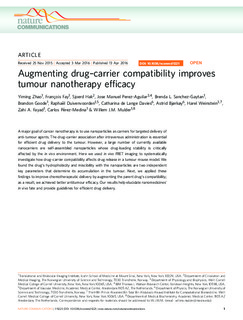| dc.contributor.author | Zhao, Yiming | |
| dc.contributor.author | Fay, Francois | |
| dc.contributor.author | Hak, Sjoerd | |
| dc.contributor.author | Manuel Perez-Aguilar, Jose | |
| dc.contributor.author | Sanchez-Gaytan, Brenda L | |
| dc.contributor.author | Goode, Brandon | |
| dc.contributor.author | Duivenvoorden, Raphael | |
| dc.contributor.author | Davies, Ruth Catharina de Lange | |
| dc.contributor.author | Bjørkøy, Astrid | |
| dc.contributor.author | Weinstein, Harel | |
| dc.contributor.author | Fayad, Zahi A | |
| dc.contributor.author | Perez-Medina, Carlos | |
| dc.contributor.author | Mulder, Willem J M | |
| dc.date.accessioned | 2018-01-03T08:59:21Z | |
| dc.date.available | 2018-01-03T08:59:21Z | |
| dc.date.created | 2016-09-27T09:29:48Z | |
| dc.date.issued | 2016 | |
| dc.identifier.issn | 2041-1723 | |
| dc.identifier.uri | http://hdl.handle.net/11250/2474226 | |
| dc.description.abstract | A major goal of cancer nanotherapy is to use nanoparticles as carriers for targeted delivery of anti-tumour agents. The drug–carrier association after intravenous administration is essential for efficient drug delivery to the tumour. However, a large number of currently available nanocarriers are self-assembled nanoparticles whose drug-loading stability is critically affected by the in vivo environment. Here we used in vivo FRET imaging to systematically investigate how drug–carrier compatibility affects drug release in a tumour mouse model. We found the drug’s hydrophobicity and miscibility with the nanoparticles are two independent key parameters that determine its accumulation in the tumour. Next, we applied these findings to improve chemotherapeutic delivery by augmenting the parent drug’s compatibility; as a result, we achieved better antitumour efficacy. Our results help elucidate nanomedicines’ in vivo fate and provide guidelines for efficient drug delivery. | nb_NO |
| dc.language.iso | eng | nb_NO |
| dc.publisher | Nature Publishing Group | nb_NO |
| dc.rights | Navngivelse 4.0 Internasjonal | * |
| dc.rights.uri | http://creativecommons.org/licenses/by/4.0/deed.no | * |
| dc.title | Augmenting drug-carrier compatibility improves tumour nanotherapy efficacy | nb_NO |
| dc.type | Journal article | nb_NO |
| dc.type | Peer reviewed | nb_NO |
| dc.description.version | publishedVersion | nb_NO |
| dc.source.volume | 7 | nb_NO |
| dc.source.journal | Nature Communications | nb_NO |
| dc.identifier.doi | 10.1038/ncomms11221 | |
| dc.identifier.cristin | 1386026 | |
| dc.relation.project | Norges forskningsråd: 230788 | nb_NO |
| dc.description.localcode | © 2016 The Authors. Published by Nature Publishing Group. This work is licensed under a Creative Commons Attribution 4.0 International License. | nb_NO |
| cristin.unitcode | 194,65,25,0 | |
| cristin.unitcode | 194,66,20,0 | |
| cristin.unitname | Institutt for sirkulasjon og bildediagnostikk | |
| cristin.unitname | Institutt for fysikk | |
| cristin.ispublished | true | |
| cristin.fulltext | original | |
| cristin.qualitycode | 2 | |

